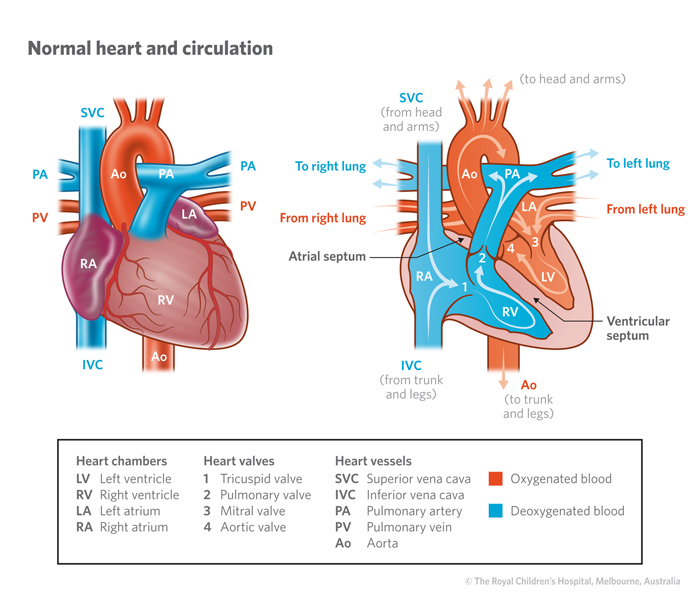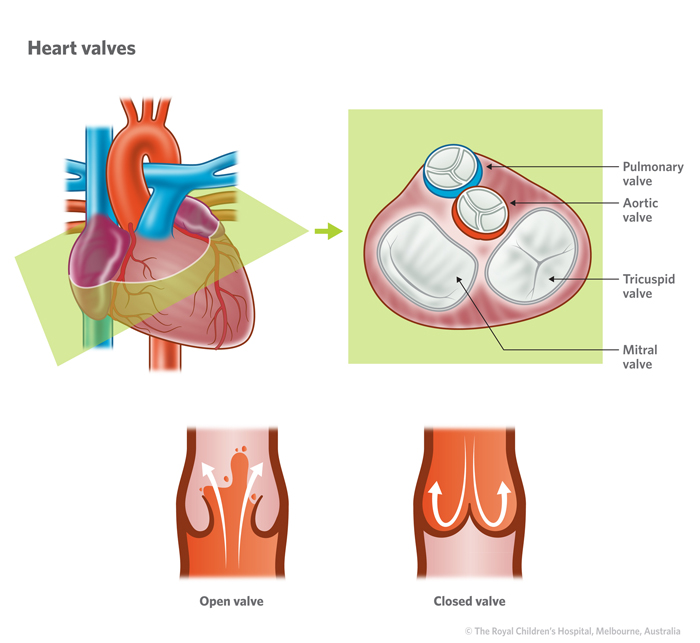The heart
The heart has the important job of pumping blood around the body. This allows the blood to carry oxygen and nutrients to the body’s organs and allows it to pass through the lungs to receive oxygen and remove carbon dioxide. Every day your heart beats around 100,000 times.
The heart receives oxygen poor blood into the right side of the heart through two big veins the superior vena cava (SVC) and the inferior vena cave (IVC). The blood first enters the right atrium (RA) then passes through the tricuspid valve into the right ventricle (RV). From the RV it is pumped to the lungs via the pulmonary arteries where it collects oxygen. The oxygen-rich blood then returns to the heart via the pulmonary veins into the left atrium (LA). It then passes through the mitral valve into the left ventricle (LV) and then it leaves the heart through the aortic valve into the aorta.
The heart’s own supply of oxygen-rich blood comes from the coronary arteries which branch off from the aorta as it leaves the heart.

The heart in a newborn baby
In a newborn infant blood can pass between the two circuits of via two temporary openings (see diagram below). The ‘ductus arteriosus’ is still open providing a connection between the aorta and the pulmonary artery while the ‘foramen ovale’ allows blood to pass between the left and right atriums (LA & RA). Within a few days the ductus closes off completely. The foramen ovale closes gradually over several weeks or months, sometimes remaining open as a tiny slit into adolescence or beyond.

Structures of the heart
Chambers
There are 4 chambers in the heart: 2 thin-walled filling chambers (the right atrium, and left atrium) and 2 thick-walled pumping chambers called the right ventricle and left ventricle. A valve sits between each atrium and ventricle. On the right side it is the tricuspid valve, and on the left it is the mitral valve.
Valves
There are valves in the heart. They act like gates that open and close to allow blood to only travel in one direction through the heart. They are made up of 2 or 3 flaps called leaflets. The valves are situated at the junction of the atriums with the ventricles (tricuspid and mitral valves) and at the origin of the major arteries from the ventricles (pulmonary and aortic valves). The tricuspid and mitral valves open during the filling or relaxation phase of the heart while the pulmonary and aortic valves open during the pumping or contraction phase. This sequencing of opening and closing keeps blood flowing forward through the heart and around the body.

Coronary arteries
These arteries make sure the heart receives its own constant supply of oxygen rich blood. The coronary arteries branch off from the aorta as it leaves the heart and run around the outside of the heart.
Pulmonary veins
These carry oxygen rich blood back to the heart from the lungs. They are the only veins in the body to carry oxygen rich blood. They connect into the left atrium of the heart.
Pulmonary arteries
These carry oxygen poor blood from the right side of the heart to the lungs. The main pulmonary artery (PA) leaves the right ventricle and then divides into right and left branch PAs. These continue to divide into smaller and smaller vessels in the lungs.
The aorta
This is the main artery of the heart. It carries oxygen-rich blood way from the heart and directs it to all the body’s other vital organs such as the brain, liver and kidneys.
Developed by Queensland Paediatric Cardiac Service. We acknowledge the input of consumers and carers.
Resource No: FS267. Reviewed: February 2024.
llustrations republished with permission from The Royal Children's Hospital, Melbourne, Australia. Images subject to copyright.
Disclaimer: This information has been produced by healthcare professionals as a guideline only and is intended to support, not replace, discussion with your child’s doctor or healthcare professionals. Information is updated regularly, so please check you are referring to the most recent version. Seek medical advice, as appropriate, for concerns regarding your child’s health.